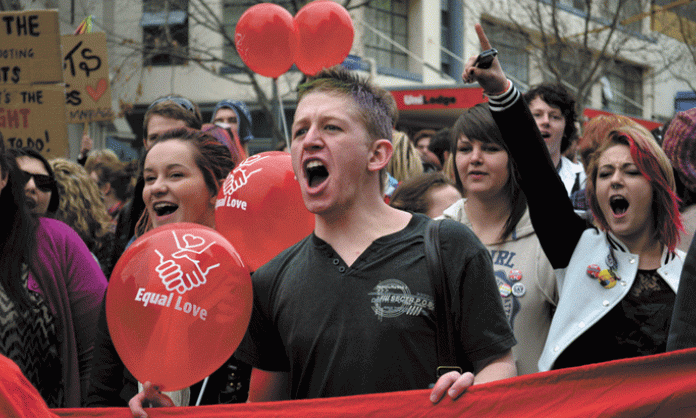This year marks ten years since the Howard government, with the backing of the Labor Party, amended the Marriage Act to formally deny marriage rights to LGBTI people.
For a decade now all non-heterosexual relationships have been relegated to second class status.
But this provocative act from the political establishment has not been met with passivity or resignation. Instead, the years since 2004 have seen a determined movement emerge demanding equality and an end to all homophobic discrimination.
It has involved young people, students groups, LGBTI organisations, trade unions, political organisations as well as many thousands of individuals coming together to demand marriage rights be extended to all.
It has been defined by consistently large and spirited demonstrations around the country. These demonstrations have defied the established trend in Australian politics (whereby initial outrage over social injustices frequently gives way to resignation) and highlighted the depth of feeling regarding equal rights.
The mobilisations have also been crucial in keeping the issue of marriage equality in the public spotlight and pressure on the politicians.
This campaigning has made a tangible difference. Most notably, it has helped win more people to the cause of equal rights. Ten years ago, around two thirds of the public supported the ban.
Years of protesting, talking about equal rights and building a civil rights movement on the streets has meant that nearly the same proportion now support equal marriage rights.
Many thousands have been prompted to question homophobic attitudes and develop identification with the struggles of LGBTI people because marriage equality advocates have continued to argue, take action and confront the homophobia of the government and society.
The campaign has also led the ALP to change its platform to support equality.
The fact that this policy shift was rendered academic by the subsequent adoption of a conscience vote on the question does not entirely negate the importance of the change.
As well, various state and territory governments have attempted to pass (or have passed) legislation for marriage equality in defiance of the federal government. While none of these moves has successfully established marriage equality, they reflect real progress and remind the bigots in Canberra that this campaign is not going to retreat or give up easily.
But perhaps the most important effect the campaign has had has been on the many thousands of people who have been involved. The fight for marriage equality has engaged a new layer people, both LGBTI and their straight allies, in political action.
Young people have been particularly prominent. Many are motivated not so much by the explicit desire to marry, but by the gross injustice of discrimination and a commitment to the concept of equality.
The campaign has brought young and old into conflict with a political establishment determined to maintain homophobic discrimination.
It has helped politicise a new layer of people who, through taking to the streets together in large numbers, have built a sense of solidarity and confidence which has been essential for LGBTI people developing a sense of pride in a society saturated by homophobia.
Being public, unapologetic and challenging the homophobic organisations and individuals in society, just as the gay liberationists did in the past, is key to this.
This year will be an important Year of Action for the marriage equality campaign around the country. The tenth anniversary of the passing of this disgraceful law should be an occasion to redouble our efforts, hits the streets with greater determination and force the archaic and bigoted Abbott government to listen.









